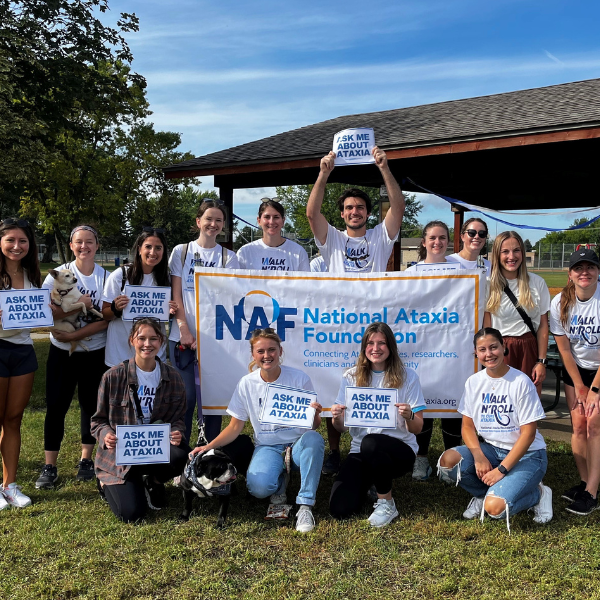
Guest Author: Beverly Nelson
Becoming a caregiver for someone with ataxia changes the rhythm of your days almost overnight. The mix of medical responsibilities, emotional support, and constant problem-solving can be both meaningful and exhausting. Without a plan for your own well-being, the role can quietly erode your health and joy. You might already notice moments where patience feels thin, decisions come slower, or small frustrations stick around longer than they used to. That’s your mind and body sending a signal — one you can’t afford to ignore. This guide offers practical, grounded strategies to protect your resilience, so you can keep showing up fully for the person who needs you.
Recognizing Stress & Signs of Burnout
It’s easy to normalize the fatigue that creeps into caregiving, but over time, those long days and short nights can push you into burnout. Watch for the classic markers — irritability that’s quicker to surface, trouble concentrating, and a sense of emotional distance from the person you’re helping. Physical cues like headaches, stomach issues, or changes in appetite are equally telling. Learn the signs of caregiver burnout so you can spot them early, before they snowball.
Wellness Alternatives & Restorative Options
Safe, alternative stress-reduction modalities can offer gentle support without overhauling your routine. Mind-body practices like yoga combine movement with breathwork, helping release tension while building resilience over time. Aromatherapy, especially with calming scents like lavender or chamomile, can create an immediate shift in mood when used in a diffuser or as part of a nightly wind-down.
Prioritizing Self-Compassion
Many new caregivers put themselves last, believing every ounce of energy should go toward the patient. But ignoring your own needs eventually harms both of you. Self-compassion isn’t indulgence — it’s maintenance for the person keeping things running. Acknowledge the weight of the role and offer yourself the same understanding you’d give a friend in your position. This is why caregivers need self-compassion as a daily practice. It helps you replace guilt with permission, judgment with patience. Those internal shifts make it easier to recover from tough days and approach the next with renewed focus.
Building a Personalized Self-Care Routine
Generic wellness advice rarely fits neatly into a caregiver’s schedule. The key is building a rhythm that fits your actual life, not an idealized version. Start with short, non-negotiable actions — maybe a quiet cup of coffee before anyone else wakes up or a brief walk after lunch. Keep it flexible so you can adapt on chaotic days without abandoning the whole plan. Use a caregiver self-care checklist as inspiration, then adjust it for your energy levels, responsibilities, and personal preferences. The more tailored it feels, the more likely you’ll keep it going.
Support Networks & Asking for Help
Trying to carry the entire load alone is unsustainable. Building a network of friends, family, and community resources lightens the emotional and logistical weight. The hard part is asking — many caregivers feel it’s their job to handle everything. Start small: delegate one task, like meal prep or an errand, to someone you trust. This can grow into a habit where you ask for help as a caregiver without guilt or hesitation. Over time, your network becomes not just a backup plan, but an active part of the care ecosystem.
Stress Relief Practices
Tension builds quickly when you’re managing medical appointments, household duties, and the unpredictable nature of ataxia symptoms. Quick, repeatable stress relief tools can prevent that buildup from turning into overwhelm. You don’t need an hour-long meditation — sometimes two minutes is enough. Try grounding exercises, mindful breathing, or short body stretches that fit into your day without rearranging it. When relief practices become part of your default responses, stress stops being the constant background noise.
Ataxia-Specific Self-Care Tips
Caring for someone with ataxia comes with unique challenges — mobility changes, speech difficulties, and potential complications that require extra vigilance. Your self-care must adapt to these realities. Learn energy-saving techniques for transfers, communication tools to ease conversations, and safe home modifications to prevent falls. Small adjustments can prevent physical strain and emotional fatigue. The more you understand the condition’s daily impact, the better you can protect both your loved one and yourself.
The best caregiving comes from a place of stability, not self-sacrifice. Protecting your energy, emotional health, and physical strength is an investment in your ability to keep showing up. When you recognize early signs of burnout, practice self-compassion, and keep a personalized routine, you create a sustainable path forward.
Disclaimer: Sharing this information and/or mention of products or services does not imply endorsement of any product or company by NAF. Always seek the advice of your physician or other qualified health care provider with any questions you may have regarding a medical condition or treatment and before undertaking a new health care regimen, exercise, treatment, or nutritional supplement.
About the Author
Beverly Nelson created StandUpForCaregivers.org, which aims to protect and advocate for the health and well-being of adult caregivers.









